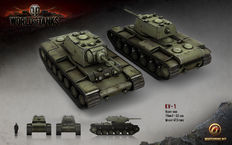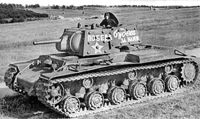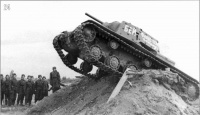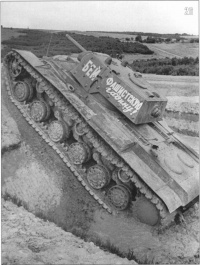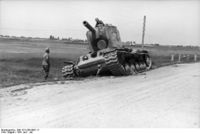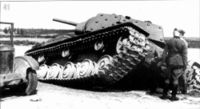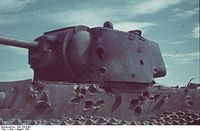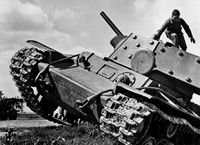KV
| Revision as of 13:36, 9 May 2011 | Revision as of 14:34, 9 May 2011 False information fixed. | |||
| Line 32: | Line 32: | |||
| Most people will find the KV's playing style different from what they expected in a heavy tank, having just come out of a T28. At stock, it's armed with an adequate 76mm gun, but is very slow and certainly not agile, so use extreme caution when crossing open fields or terrain; better yet, don't try until you're used to this behemoth. Its slow nature makes the KV a prime target for snipers and arty, so be aware of your surroundings. | Most people will find the KV's playing style different from what they expected in a heavy tank, having just come out of a T28. At stock, it's armed with an adequate 76mm gun, but is very slow and certainly not agile, so use extreme caution when crossing open fields or terrain; better yet, don't try until you're used to this behemoth. Its slow nature makes the KV a prime target for snipers and arty, so be aware of your surroundings. | |||
| ? | The KV is best with the 107mm gun, which will allow it to sit at range and hit targets from a distance before they can close in and destroy it. The KV with the 122mm gun can be a surprisingly fun tank to play, but don't expect to be doing much when you get thrown in with the big boys. In such battles, it is best to go after tanks around your tier, or defend the base from early rushers or scouts who may try to go for a fast cap or quick arty kill. But its biggest gun, the 152mm, is a mixture of reward and pain: it has the ability to shock high-tier drivers with its massive damage output, if using High Explosive (HE) shells, but the down-side is the 152mm's very-long reload time- the longest of any 152mm tank gun. This fact is not lost on your enemy, and he will try to exploit this long-reload time to his advantage. The key to the KV's survival is situational awareness, remain as distant as possible from your faster, more agile opponent, and select your targets wisely | + | The KV is best with the 107mm gun, which will allow it to sit at range and hit targets from a distance before they can close in and destroy it. The KV with the 122mm gun can be a surprisingly fun tank to play, but don't expect to be doing much when you get thrown in with the big boys. In such battles, it is best to go after tanks around your tier, or defend the base from early rushers or scouts who may try to go for a fast cap or quick arty kill. But its biggest gun, the 152mm, is a mixture of reward and pain: it has the ability to shock high-tier drivers with its massive damage output, if using High Explosive (HE) shells, but the down-side is the 152mm's very-long reload time- the longest of any 152mm tank gun. This fact is not lost on your enemy, and he will try to exploit this long-reload time to his advantage. The key to the KV's survival is situational awareness, remain as distant as possible from your faster, more agile opponent, and select your targets wisely. | |
| ? | According to a recent revise of the Tech Trees the KV will be split into the two seperate tanks: the KV-1 | + | According to a recent revise of the Tech Trees, the KV will be split into the two seperate tanks: the KV-1 and the KV-2. The KV-2 will be provided as an extra tank with an extra space and crew of 100% if you have the KV tank in your garage and it has the KV-2 turret researched. | |
| ? | It unlocks | + | It unlocks its heavily-armored cousin the [[KV-3]], the nimble [[KV-1S]], and the fear-inducing [[S-51]]. | |
| }} | }} | |||
Revision as of 14:34, 9 May 2011
KV
| USSR | Heavy Tank | Tier V |
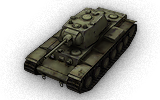
The KV is a tier 5 USSR heavy tank which marks the start of the USSR heavy-tank branch.
Most people will find the KV's playing style different from what they expected in a heavy tank, having just come out of a T28. At stock, it's armed with an adequate 76mm gun, but is very slow and certainly not agile, so use extreme caution when crossing open fields or terrain; better yet, don't try until you're used to this behemoth. Its slow nature makes the KV a prime target for snipers and arty, so be aware of your surroundings.
The KV is best with the 107mm gun, which will allow it to sit at range and hit targets from a distance before they can close in and destroy it. The KV with the 122mm gun can be a surprisingly fun tank to play, but don't expect to be doing much when you get thrown in with the big boys. In such battles, it is best to go after tanks around your tier, or defend the base from early rushers or scouts who may try to go for a fast cap or quick arty kill. But its biggest gun, the 152mm, is a mixture of reward and pain: it has the ability to shock high-tier drivers with its massive damage output, if using High Explosive (HE) shells, but the down-side is the 152mm's very-long reload time- the longest of any 152mm tank gun. This fact is not lost on your enemy, and he will try to exploit this long-reload time to his advantage. The key to the KV's survival is situational awareness, remain as distant as possible from your faster, more agile opponent, and select your targets wisely.
According to a recent revise of the Tech Trees, the KV will be split into the two seperate tanks: the KV-1 and the KV-2. The KV-2 will be provided as an extra tank with an extra space and crew of 100% if you have the KV tank in your garage and it has the KV-2 turret researched.
It unlocks its heavily-armored cousin the KV-3, the nimble KV-1S, and the fear-inducing S-51.Modules
Historical Info
Development
After disappointing results with the multi-turreted T-35 heavy tank, Soviet tank designers started drawing up replacements. The T-35 conformed to the 1920s notion of a 'breakthrough tank' with very-heavy firepower and armor protection, but poor mobility. The Spanish Civil War demonstrated the need for much-heavier armor on tanks, and was the main influence on Soviet tank design just prior to World War II. Several competing designs were offered, and even more were drawn up prior to reaching prototype stage. All had heavy armor, torsion-bar suspension, wide tracks, and were of welded and cast construction. One of the main competing designs was the SMK, which lowered the number of turrets from the T-35's five to two, mounting the same combination of 76.2 mm and 45 mm weapons. When two prototypes were ordered though, it was decided to create one with only a single turret, but more armor. This new single-turret tank was the KV. The smaller hull and single turret enabled the designer to install heavy frontal and turret armor while keeping the weight within manageable limits.When the Soviets entered the Winter War, the SMK, KV, and a third design, the T-100, were sent to be tested in combat conditions. The heavy armor of the KV proved highly-resistant to Finnish anti-tank weapons, making it more effective than the other designs. It was soon put into production, both as the original 76-mm-armed KV-1 Heavy Tank and the 152 mm howitzer-mounting assault gun, the KV-2 Heavy Artillery Tank. The KV's strengths included armor that was impenetrable by any tank-mounted weapon then in service except at point-blank range, good firepower, and good traction on soft ground. It also had serious flaws: it was difficult to steer, the transmission was unreliable, and the ergonomics were poor, with limited visibility and no turret basket. Furthermore, the 45-ton KV was simply too heavy. This severely impacted the maneuverability, not so much in terms of maximum speed, but in it's inability to cross many bridges that medium tanks could cross. The KV outweighed most other tanks of the era, being about twice as heavy as the heaviest contemporary German tank. KVs were never equipped with a snorkeling system to ford rivers on the bottom, so they had to be left to travel to an adequate bridge. As applique armor and other improvements were added without increasing engine power, and later models were less capable of keeping up to speed with medium tanks and had more trouble with difficult terrain.
| T-35 | T-100 | SMK | KV-1 M1940 |
KV-1 M1941 |
KV-1 M1942 |
KV-1S M1942 |
KV-85 M1943 |
IS-2 M1945 |
IS-3 M1945 |
|
|---|---|---|---|---|---|---|---|---|---|---|
| Crew | 11 | 7 | 7 | 5 | 5 | 5 | 5 | 4 | 4 | 4 |
| Weight | 45 t | 58 t | 55 t | 43 t | 45 t | 47 t | 42.5 t | 46 | 46 t | 46.5 t |
| Gun | 76.2 mm M. 27/32 |
76.2 mm L-11 |
76.2 mm L-11 |
76.2 mm F-32 |
76.2 mm F-34 |
76.2 mm ZiS-5 |
76.2 mm ZiS-5 |
85 mm D-5T |
122 mm D-25T |
122 mm D-25T |
| Ammunition | 100 rds. | – | – | 111 | 111 | 114 | 114 | 70 | 28 | 28 |
| Secondary armament | 2×45 mm, 5×7.62 mm |
45 mm | 45 mm | 2×DT | 4×DT | 4×DT | 4×DT | 3×DT | 2×DT, DShK | 2×DT, DShK |
| Engine | 500 hp M-17M gasoline |
500 hp | 850 hp AM-34 |
600 hp V-2K diesel |
600 hp V-2 |
600 hp V-2 |
600 hp V-2 |
600 hp V-2 |
600 hp V-2 |
600 hp V-2-IS |
| Fuel | 910 L | – | – | 600 L | 600 L | 600 L | 975 L | 975 L | 820 L | 520 + 270 L |
| Road speed | 30 km/h | 35 km/h | 36 km/h | 35 km/h | 35 km/h | 28 km/h | 45 km/h | 40 km/h | 37 km/h | 37 km/h |
| Road range | 150 km | – | 150 km | 335 km | 335 km | 250 km | 250 km | 250 km | 240 km | 150 (225) km |
| Armour | 11–30 mm | 20–70 mm | 20–60 mm | 25–75 mm | 30–90 mm | 20–130 mm | 30–82 mm | 30–160 mm | 30–160 mm | 20–220 mm |
Improvements
By 1942, when the Germans were fielding large numbers of long-barrelled 50 mm and 75 mm guns, the KV's armor was no longer invincible. The KV-1's side, top, and turret armor could also be penetrated by the high-velocity MK 101 carried by German ground attack aircraft such as the Henschel Hs 129, requiring the installation of additional field-expedient appliqué armor. The KV-1's 76.2 mm gun also came in for criticism. While adequate against all German tanks, it was the same gun as carried by smaller, faster, and cheaper T-34 medium tanks. In 1943, it was determined that this gun could not penetrate the frontal armor of the new Tiger, the first German heavy tank, fortunately captured near Leningrad. The KV-1 was also much more difficult to manufacture and thus, more expensive than the T-34. In short, it's advantages no longer outweighed it's drawbacks. Nonetheless, because of it's initial superior performance, the KV-1 was chosen as one of the few tanks to continue being built following the Soviet reorganization of tank production. Due to the new standardization, it shared the similar engine (the KV used a 600 hp V-2K modification of the T-34's V-2 diesel engine) and gun (the KV had a ZiS-5 main gun, while the T-34 had a similar F-34 main gun) as the T-34, was built in large quantities, and received frequent upgrades. When production shifted to the Ural Mountains 'Tankograd' complex, the KV-2 was dropped. While impressive on paper, it had been designed as a slow-moving bunker-buster. It was less useful in the highly-mobile, fluid warfare that developed in World War II. The turret was so heavy it was difficult to traverse on non-level terrain, and it was expensive to produce. Only about 250 KV-2s were made, all in 1940-41, making it one of the rarer Soviet tanks.
As the war continued, the KV-1 continued to get more armor to compensate for the increasing effectiveness of German weapons. This culminated in the KV-1 model 1942 (German designation KV-1C), which had very heavy armor, but lacked a corresponding improvement to the engine. Tankers complained that although they were well-protected, their mobility was poor and they had no firepower advantage over the T-34 medium tank. In response to criticisms, the lighter KV-1S (Russian language: КВ-1С) was released, with thinner armor and a smaller, lower turret in order to reclaim some speed. Importantly, the KV-1S also had a commander's cupola with all-around vision blocks, a first for a Soviet heavy tank. However, the thinning-out of the armor called into question why the tank was being produced at all, when the T-34 could seemingly do everything the KV could do and much more cheaply. The Soviet heavy tank program was close to cancellation in mid-1943.The appearance of the German Panther tank in the summer of 1943 convinced the Red Army to make a serious upgrade of it's tank force for the first time since 1941. Soviet tanks needed bigger guns to take on the growing numbers of Panthers and the few Tigers. A stopgap upgrade to the KV series was the short-lived KV-85 or Objekt 239. This was a KV-1S with a new turret designed for the IS-85, mounting the same 85 mm D-5T gun as the SU-85 and early versions of the T-34-85. Already-high demand for the gun slowed production of the KV-85 tremendously, and only 148 were built before the KV design was replaced. The KV-85 was produced in the fall and winter of 1943-44; they were sent to the front as of September 1943, and production of the KV-85 was stopped by the spring of 1944 once the IS-2 entered full scale production.
Combat history
Raseiniai
When Operation Barbarossa began, the Red Army was equipped with 508 new KV tanks. It's armor was so effective that the Germans were incapable of destroying it with their tanks or anti-tank weapons, and had to rely on air support and 88 mm anti-aircraft artillery (flak) or 105 mm howitzers to knock them out. Most of these tanks, and the effective T-34s, were parcelled out to units in small numbers and poorly supplied, but at the Battle of Raseiniai they were used to good effect. On 23–24 June, a single KV-2 effectively pinned down elements of the German 6th Panzer Division for a full day at the bridgeheads of the Dubysa River below Raseiniai, Lithuania, playing a prominent role in delaying the advance of Panzergruppe 4 on Leningrad until it ran out of ammunition and the crew was forced to abandon the tank and withdraw. According to Panzer Operations, however, the tank (said to be a KV-1), after destroying several antitank guns, their crews, and an 88 mm flak gun, was hit repeatedly with rounds from another 88 mm gun. The crew was knocked unconscious, and recovered only to be killed by an exploding grenade. They were buried with full honors, uncommon for other troops. The English version indicates that Erhard Raus, the author, may have mistaken similar events and people, so this may be an error.
Krasnogvardeysk
On August 14, 1941, the vanguard of the German 8th Panzer Division approached Krasnogvardeysk (Gatchina) near Leningrad (St Petersburg), and the only Soviet force available at the time to attempt to stop the German advance consisted of five well-hidden KV-1 tanks, dug in within a grove at the edge of a swamp. KV-1 tank no. 864 was commanded by the leader of this small force, Lieutenant Zinoviy Kolobanov. German forces attacked Krasnogvardeysk from three directions. Near Noviy Uchkhoz settlement the geography favored the Soviet defenders as the only road in the region passed the swamp, and the defenders commanded this choke point from their hidden position. Lieutenant Kolobanov had carefully studied the situation and readied his detachment the day before. Each KV-1 tank carried twice the normal amount of ammunition, two-thirds being armor-piercing rounds. Kolobanov ordered his other commanders to hold their fire and await orders. He did not want to reveal the total force, so only one exposed tank at a time would engage the enemy. On August 14, the German 8th Panzer Division's vanguard ventured directly into the well-prepared Soviet ambush, with Kolobanov's tank knocking out the lead German tank with it's first shot. The Germans falsely assumed that their lead tank had hit an anti-tank mine, and failed to realize that they had been ambushed. The German column stopped, giving Kolobanov the opportunity to destroy the second tank. Only then did the Germans realize they were under attack, but they failed to find the source of the shots. While the German tanks were firing blindly, Kolobanov knocked out the trailing German tank, thus boxing in the entire column.
Although the Germans correctly guessed the direction of fire, they could only spot Lieutenant Kolobanov's tank, and now attempted to engage an unseen enemy. German tanks moving off the road bogged down in the surrounding soft ground, becoming easy targets. 22 German tanks and 2 towed artillery pieces fell victim to Kolobanov's No. 864 before it ran out of ammunition. Kolobanov ordered in another KV-1, and 21 more German tanks were destroyed before the half-hour battle ended. A total of 43 German tanks were destroyed by just five Soviet KV-1s (two more remained in reserve).After the battle, the crew of No. 864 counted a total of 135 hits on their tank, none of which had penetrated the KV-1's armor. Lieutenant Kolobanov was awarded the Order of Lenin, while his driver Usov was awarded the Order of the Red Banner. Later on, former Captain Zinoviy Kolobanov was again decorated by Soviet authorities, despite having been convicted and downgraded after the Winter War for "fraternizing with the enemy." After the end of World War II, Lieutenant Kolobanov served in the Soviet occupation zone in East Germany, where he was convicted again when a subordinate escaped to the British occupation zone, and was transferred to the reserves. The battle for Krasnogvardeysk was covered up by Soviet propaganda. A monument dedicated to this battle was installed in the village of Noviy Uchkhoz in 1980, at the place where Kolobanov's KV-1 was dug in, due solely to the demands of the villagers. Unfortunately, it was impossible to find a KV-1 tank, so an IS-2 heavy tank was installed there instead.
The Soviet victory was the result of a well-planned ambush in advantageous ground and of technical superiority. Most of the German tanks in this battle were Panzer IIs, armed with 20 mm guns, and a few Panzer IIIs armed with 37 mm KwK 36 L/46.5 guns. The German tank guns had neither the range nor the power of the 76 mm main gun of a KV-1, and the narrower track width of the German tanks caused them to become trapped in the swampy ground.
This heavy soviet tank KV-1 was lifted from the bottom of Neva river spring 2003. No crew was found inside and its hatches were half opened.

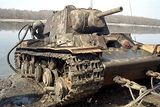 KV-1 tank (its number 76 is on the rear side of the turret). The vehicle was shot dew in the vicinity of Luga July 1941.
KV-1 tank (its number 76 is on the rear side of the turret). The vehicle was shot dew in the vicinity of Luga July 1941.
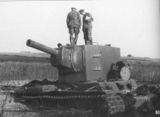
 Captured KV-2 left in tank park of one of the Soviet units. At the right side one can see a KhT-26 flame thrower tank, Ukraine, June 1941.
Captured KV-2 left in tank park of one of the Soviet units. At the right side one can see a KhT-26 flame thrower tank, Ukraine, June 1941.
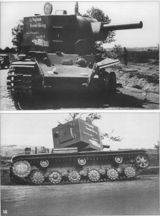

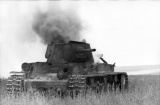
| Light Tanks | MS-1 • BT-2 • Tetrarch • T-26 • T-60 • BT-7 • BT-SV • LTP • M3 Light • T-127 • T-46 • T-70 • A-20 • T-50 • T-80 • Valentine II • T-50-2 • MT-25 |
| Medium Tanks | A-32 • T-28 • Matilda IV • T-34 • T-34-85 • A-43 • KV-13 • T-43 • A-44 • T-44 • Object 416 • T-54 • Object 430 II • Object 283 • T-62A • Object 140 • Object 430 |
| Heavy Tanks | Churchill III • KV • KV-1 • KV-220 • KV-220 Beta-Test • KV-1S • KV-2 • T-150 • IS • KV-3 • IS-3 • IS-6 • KV-4 • KV-5 • IS-8 • ST-I • IS-4 • IS-7 |
| Tank Destroyers | AT-1 • SU-76 • SU-85B • SU-85 • SU-85I • SU-100 • SU-100Y • SU-100M1 • SU-122-44 • SU-152 • ISU-152 • SU-101 • Object 704 • SU-122-54 • Object 263 • Object 268 |
| Self-Propelled Guns | SU-18 • SU-26 • SU-5 • SU-122A • SU-8 • S-51 • SU-14-1 • SU-14-2 • 212A • Object 261
|
